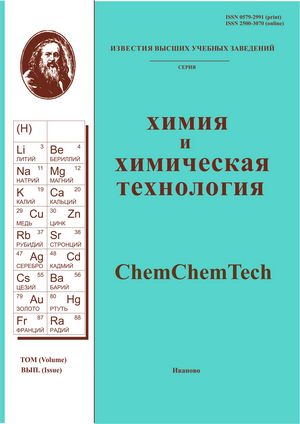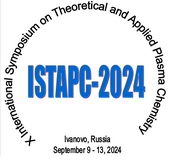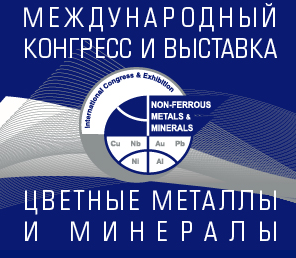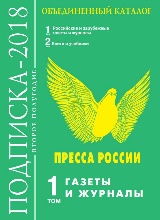ПОЛУЧЕНИЕ НАНОКРИСТАЛЛИЧЕСКОЙ ЦЕЛЛЮЛОЗЫ ГИДРОЛИЗОМ В СМЕСИ СОЛЯНОЙ И АЗОТНОЙ КИСЛОТ
Аннотация
В работе применен гидротермальный метод получения нанокристаллической целлюлозы (НКЦ) в смеси соляной и азотной кислот при молярном соотношении 8:2, 7:3, 6:4 и 5:5. Гидролиз сульфатной целлюлозы в смеси азотной и соляной кислот проводили в герметичном толстостенном сосуде из нержавеющей стали с тефлоновым вкладышем в течение 3 ч при 110 °С. Свойства НКЦ охарактеризованы с использованием различных методов: элементного анализа, термогравиметрического анализа, ИК спектроскопии, поляризационной оптической и электронной сканирующей микроскопии, метода динамического рассеяния света. Определен выход НКЦ, размер и заряд частиц, степень полимеризации, температура термодеструкции, изучена морфология образцов. Самый высокий выход (32 %) наблюдается при соотношении соляной и азотной кислот 7:3. Найдено, что частицы НКЦ имеют сферическую форму со средним размером 60-80 нм. Сделано предположение, что в присутствии сильного окислителя происходит гидролиз не только аморфных областей целлюлозы, но и частично кристаллических, что сказывается на конечной форме частиц НКЦ. Показано, что гидролиз в смеси соляной и азотной кислот вызывает окисление первичных гидроксильных групп пиранозного кольца целлюлозы и образование поверхностных карбоксильных групп. Водные суспензии НКЦ демонстрируют высокую коллоидную стабильность вследствие достаточно большого поверхностного заряда. Отмечается значительное повышение термической устойчивости НКЦ по сравнению с образцом НКЦ, полученным стандартным сернокислотным гидролизом: температура термического разложения увеличивается на 130-148 °С.
. . . . . . . . . . . . . . . . . . . . . . . . . . . . . . . . . . . . . . . . . . .
Литература
Rogovin Z.A. Chemistry of cellulose. M.: Khimiya. 1972. 520 p. (in Russian). Роговин З.А. Химия целлюлозы. М.: Химия. 1972. 520 с.
Bikales N.M., Segal L. Cellulose and cellulose derivatives. N.-Y.: Wiley. 1971. 501 p.
Rogovin Z.A., Gal'braikh L.S. Chemical transformations and modification of cellulose. M.: Khimiya. 1979. 208 p. (in Russian). Роговин З.А., Гальбрайх Л.С. Химические превращения и модификация целлюлозы. М.: Химия. 1979. 208 с.
Panov V.P., Zhbankov R.G. Intra- and intermolecular interactions in carbohydrates: (Nonvalent interactions and conformations). Minsk: Nauka i tekhnika. 1988. 356 p. (in Russian). Панов В.П., Жбанков Р.Г. Внутри- и межмолекулярные взаимодействия в углеводах (невалентные взаимодействия и конформации). Минск: Наука и техника. 1988. 356 с.
Udoratina E.V., Torlopov M.A. Partial destruction of cellulose in water and in acetic acid in presence of heteropolyacids. Izv. Vyssh. Uchebn. Zaved. Khim. Khim. Tekhnol. 2013. V. 56. N 6. P. 69-75 (in Russian). Удоратина Е.В., Торлопов М.А. Частичная деструкция целлюлозы в воде и в уксусной кислоте в присутствии гетерополикислот. Изв. вузов. Химия и хим. технология. 2013. Т. 56. Вып. 6. С. 69-75.
Surov O.V., Voronova M.I., Rubleva N.V., Kuzmicheva L.A., Nikitin D., Choukourov A., Titov V.A., Zakharov A.G. A novel effective approach of nanocrystalline cellulose production: oxidation–hydrolysis strategy. Cellulose. 2018. V. 25. N 9. P. 5035–5048. DOI: 10.1007/s10570-018-1910-4.
Moon R.J., Martini A., Nairn J., Simonsen J., Youngblood J. Cellulose nanomaterials review: structure, properties and nanocomposites. Chem. Soc. Rev. 2011. V. 40. N 7. P. 3941-3994. DOI: 10.1039/C0CS00108B.
Giese M., Blusch L.K., Khan M.K., MacLachlan M.J. Functional Materials from Cellulose‐Derived Liquid‐Crystal Templates. Angew. Chem. Int. Ed. 2015. V. 54. N 10. P. 2888-2910. DOI: 10.1002/anie.201407141.
Zhu H., Wei Luo W., Ciesielski P.N., Fang Z., Zhu J.Y., Henriksson G., Himmel M.E., Hu L. Wood-Derived Materials for Green Electronics, Biological Devices, and Energy Applications. Chem. Rev. 2016. V. 116. N 16. P. 9305–9374. DOI: 10.1021/acs.chemrev.6b00225.
Surov O.V., Voronova M.I., Zakharov A.G. Functional materials based on nanocrystalline cellulose. Russ. Chem. Rev. 2017. V. 86. N 10. P. 907–933. DOI: 10.1070/RCR4745.
Hamad W.Y., Hu T.Q. Structure–process–yield interrelations in nanocrystalline cellulose extraction. Can. J. Chem. Eng. 2010. V. 88. N 3. P. 392-402. DOI: 10.1002/cjce.20298.
Lin N., Dufresne A. Surface chemistry, morphological analysis and properties of cellulose nanocrystals with gradiented sulfation degrees. Nanoscale. 2014. V. 6. N 10. P. 5384–5393. DOI: 10.1039/C3NR06761K.
Voronova M.I., Surov O.V., Zakharov A.G. Nanocrystalline cellulose with various contents of sulfate groups. Carbohyd. Polym. 2013. V. 98. N 1. P. 465–469. DOI: 10.1016/j.carbpol.2013.06.004.
Yu H.Y., Qin Z.Y., Liang B.L., Liu N., Zhou Z., Chen L. Facile extraction of thermally stable cellulose nanocrystals with a high yield of 93% through hydrochloric acid hydrolysis under hydrothermal conditions. J. Mater. Chem. A. 2013. V. 1. N 12. P. 3938–3944. DOI: 10.1039/C3TA01150J.
Camarero Espinosa S., Kuhnt T., Foster E.J., Weder C. Isolation of thermally stable cellulose nanocrystals by phosphoric acid hydrolysis. Biomacromolecules. 2013. V. 14. N 4. P. 1223–1230. DOI: 10.1021/bm400219u.
Hamid S.B.A., Zain S.K., Das R., Centi G. Synergic effect of tungstophosphoric acid and sonication for rapid synthesis of crystalline nanocellulose. Carbohydr. Polym. 2016. V. 138. P. 349–355. DOI: 10.1016/j.carbpol.2015.10.023.
Jonoobi M., Oladi R., Davoudpour Y., Oksman K., Dufresne A., Hamzeh Y., Davoodi R. Different preparation methods and proper-ties of nanostructured cellulose from various natural resources and residues: a review. Cellulose. 2015. V. 22. N 2. P. 935–969. DOI: 10.1007/s10570-015-0551-0.
Chen G.Y., Yu H.Y., Zhang C.H., Zhou Y., Yao J.M. A universal route for the simultaneous extraction and functionalization of cellulose nanocrystals from industrial and agricultural celluloses. J. Nanopart. Res. 2016. V. 18. N 2. P. 1–14. DOI: 10.1007/s11051-016-3355-8.
Chen L., Zhu J.Y., Baez C., Kitin P., Elder T. Highly thermalstable and functional cellulose nanocrystals and nanofibrils produced using fully recyclable organic acids. Green Chem. 2016. V. 18. N 13. P. 3835–3843. DOI: 10.1039/C6GC00687F.
Yu H.Y., Zhang D.Z., Lu F.F., Yao J. New approach for single - step extraction of carboxylated cellulose nanocrystals for their use as adsorbents and flocculants. ACS Sustain. Chem. Eng. 2016. V. 4. N 5. P. 2632–2643. DOI: 10.1021/acssuschemeng.6b00126.
Titova Yu.V., Voronova M.I., Maksimov A.I. Influence of gasdischarge plasma treatment in the electrolyte bulk on the cellulose properties. Russ. J. Appl. Chem. 008. V. 81. N 5. P. 854–857. DOI: 10.1134/s107042720805025x.
Zhang K., Sun P., Liu H., Shang S., Song J., Wang D. Extraction and comparison of carboxylated cellulose nanocrystals from bleached sugarcane bagasse pulp using two different oxidation methods. Carbohydr. Polym. 2016. V. 138. P. 237–243. DOI: 10.1016/j.carbpol.2015.11.038.
Cheng M., Qin Z.Y., Liu Y.N., Qin Y.F., Li T., Chen L., Zhu M.F. Efficient extraction of carboxylated spherical cellulose nanocrystals with narrow distribution through hydrolysis of lyocell fibers by using ammonium persulfate as an oxidant. J. Mater. Chem. A. 2014. V. 2. N 1. P. 251–258. DOI: 10.1039/C3TA13653A.
Kumar V., Yang T. HNO3/H3PO4–NaNO2 mediated oxidation of cellulose—preparation and characterization of bioabsorbable oxidized celluloses in high yields and with different levels of oxidation. Carbohydr. Polym. 2002. V. 48. N 4. P. 403–412. DOI: 10.1016/S0144-8617(01)00290-9.
Xu Y.H., Liu X., Liu X., Tan J.L., Zhu H.L. Influence of HNO3/H3PO4–NaNO2 mediated oxidation on the structure and properties of cellulose fibers. Carbohydr. Polym. 2014. V. 111. P. 955–963. DOI: 10.1016/j.carbpol.2014.05.029.
Leung A.C., Hrapovic S., Lam E., Liu Y., Male K.B., Mahmoud K.A., Luong J.H. Characteristics and properties of carboxylated cellulose nanocrystals prepared from a novel one-step procedure. Small. 2011. V. 7. N 3. P. 302–305. DOI: 10.1002/smll.201001715.
Cheng M., Qin Z., Chen Y., Liu J., Ren Z. Facile one-step extraction and oxidative carboxylation of cellulose nanocrystals through hydrothermal reaction by using mixed inorganic acids. Cellulose. 2017. V. 24. N 8. P. 3243–3254. DOI: 10.1007/s10570-017-1339-1.
Beck S., Bouchard J., Berry R. Dispersibility in Water of Dried Nanocrystalline Cellulose. Biomacromolecules. 2012. V. 13. N 5. P. 1486–1494. DOI: 10.1021/bm300191k.
Boluk Y., Danumah C. Analysis of cellulose nanocrystal rod lengths by dynamic light scattering and electron microscopy. J. Nanopart. Res. 2014. V. 16. N 1. P. 2174. DOI: 10.1007/s11051-013-2174-4.
Brinkmann A., Chen M., Couillard M., Jakubek Z.J., Leng T., Johnston L.J. Correlating Cellulose Nanocrystal Particle Size and Surface Area. Langmuir. 2016. V. 32. N 24. P. 6105–6114. DOI: 10.1021/acs.langmuir.6b01376.
Beuguel Q., Tavares J.R., Carreau P.J., Heuzey M.-C. Ultrasonication of spray- and freeze-dried cellulose nanocrystals in water. J. Colloid Interf. Sci. 2018. V. 516. P. 23–33. DOI: 10.1016/j.jcis.2018.01.035.
Ioelovich M., Leykin A. Nano-cellulose and its applications. Sci. Israel – Technolog. Advant. 2004. V. 6. N 3-4. P. 17-25.
Hamad W.Y., Hu T.Q. Structure–Process–Yield Interrelations in Nanocrystalline Cellulose Extraction. Can. J. Chem. Eng. 2010. V. 88. N 3. P. 392-402. DOI: 10.1002/cjce.20298.
Yu H., Qin Z., Liang B., Liu N., Zhou Z., Chen L. Facile extraction of thermally stable cellulose nanocrystals with a high yield of 93% through hydrochloric acid hydrolysis under hydrothermal conditions. J. Mater. Chem. A. 2013. V. 1. P. 3938–3944. DOI: 10.1039/c3ta01150j.
Kontturi E., Meriluoto A., Penttilä P.A., Baccile N., Malho J.-M., Potthast A., Rosenau T., Ruokolainen J., Serimaa R., Laine J., Sixta H. Degradation and Crystallization of Cellulose in Hydrogen Chloride Vapor for High-Yield Isolation of Cellulose Nanocrystals. Angew. Chem. Int. Ed. 2016. V. 55. P. 14455 –14458. DOI: 10.1002/anie.201606626.
Lorenz M., Sattler S., Reza M., Bismarck A., Kontturi E. Cellulose nanocrystals by acid vapour: towards more effortless isolation of cellulose nanocrystals. Faraday Discuss. 2017. V. 202. P. 315–330. DOI: 10.1039/c7fd00053g.
Wang N., Ding E., Cheng R. Preparation and Liquid Crystalline Properties of Spherical Cellulose Nanocrystals. Langmuir. 2008. V. 24. N 1. P. 5-8. DOI: 0.1021/la702923w.
Xiong R., Zhang X., Tian D., Zhou Z., Lu C. Comparing microcrystalline with spherical nanocrystalline cellulose from waste cotton fab-rics. Cellulose. 2012. V. 19. N 4. P.1189–1198. DOI: 10.1007/s10570-012-9730-4.



















